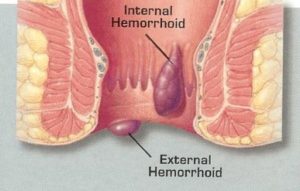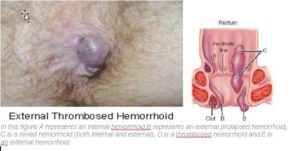Are you bleeding? Having pain? Any puffiness or swelling on the bottom? These could all be symptoms of hemorrhoids. But what are hemorrhoids and more importantly, how can they be prevented and treated? Here I answer your questions about this most common but dreaded malady.
- What is a hemorrhoid?
A hemorrhoid is an anal cushion of tissue containing blood vessels, muscle, and connective tissue. When this tissue is engorged or swollen, there is the possibility of discomfort or bleeding. Contrary to popular belief, a hemorrhoid is not a vein. Once the swelling from the hemorrhoid resolves, a skin tag may be left. There can be one or multiple tags present. Removal of the anal skin tag is not necessary unless they itch, bleed, or create difficulty maintaining proper perianal hygiene.

Anal Skin Tags
- What causes a hemorrhoid?
The exact cause of a hemorrhoid is unknown. Any action that increases pressure around the anus (such as straining to have a bowel movement, constipation, diarrhea, persistent heavy coughing, pregnancy, or lifting heavy objects) may lead to swelling or bleeding from the hemorrhoid.
- How common are hemorrhoids?
A report from the National Center for Health Statistics found that 10 million people in the US complained of troubles from hemorrhoids. Over 1 million prescriptions are written per year for medications for hemorrhoids. The peak age is 45-65 years of age, even though any age could potentially be affected.
- What are the symptoms of hemorrhoids?
Symptoms are dependent on the type of hemorrhoid.

The symptoms from internal hemorrhoids classically involve painless bright red bleeding that occurs during a bowel movement. Internal hemorrhoids may also prolapse or protrude outside of the anus when having bowel movements. They may reduce or go back in on their own; however, sometimes they require manual reduction (pushing them back into the anus). Pain is generally not a symptom of internal hemorrhoids, but if pain is present, it may be because of a prolapse or thrombosis of the internal hemorrhoid. A thrombosis occurs when the blood within the hemorrhoid clots and the hemorrhoid becomes very tender.
There are 4 grades of internal hemorrhoids:
Grade 1-hemorrhoids present but do not protrude
Grade 2-hemorrhoids protrude but reduce spontaneously
Grade 3-hemorrhoids protrude but require manual reduction (pushing them into the anus)
Grade 4-hemorrhoids protrude but cannot be reduced

Prolapsed internal hemorrhoids
The symptoms from external hemorrhoids involve swelling, discomfort, bleeding, and pain. They may become thrombosed. External hemorrhoids cannot be manually reduced. Struggling to “push them in” can cause more swelling and pain.

Thrombosed external hemorrhoid
- What can I do to prevent problems with hemorrhoids?
Drink adequate volumes of fluids each day and add bulk to the diet to eliminate straining. I recommend adding fruits, vegetables, and unprocessed wheat or oat bran to the diet. An alternative is to add psyllium seed or other fiber supplements, getting 20-35 g of fiber each day. Minimize extended periods of time on the toilet as doing so can increase strain and pressure around the anus. So that means put away the cellphone, magazines, and newspapers which may increase the amount of time spent on the toilet! Hemorrhoids may also be prevented by avoiding passing hard stools and avoiding straining with bowel movements or heavy lifting. The hemorrhoid itself may not go away. However, surgery may not be needed if there is no pain, bleeding, or swelling.
- So, I have a hemorrhoid. Now what?
Hydrocortisone creams may be helpful in improving symptoms of hemorrhoids. If the over-the-counter versions do not provide relief, a stronger prescription from your doctor may be used. However, overuse of these products can make some symptoms like itching worse, which is why close follow up with the doctor is important. It is important to see an experienced physician. After a thorough examination, your doctor may conclude that symptoms reported from hemorrhoids could actually be from other anorectal diseases and conditions (i.e. anal fissures, anal abscesses, colorectal polyps, rectal prolapse).
- Do I need surgery for my hemorrhoids?
Not necessarily. The actual presence of the hemorrhoids or tags does not imply the need for surgery as long as symptoms are nonexistent, minimal, or tolerable. Your symptoms decide when and if surgery is needed.
- What are the most common procedures or surgeries for my hemorrhoids?
Internal hemorrhoids are most commonly treated with rubber band ligation, which is an in-office procedure to eliminate the symptomatic internal hemorrhoids. A ligation can also be performed in the operating room with suture. External hemorrhoids are excised in the office if a thrombosis is present (blood within the hemorrhoid clots and the hemorrhoid becomes very tender). If the external hemorrhoids are large, painful, bleeding, and not responding to medication, you may be a candidate for a surgical procedure called a hemorrhoidectomy. With this surgery, both large internal and external hemorrhoids are removed in the operating room with anesthesia.
- Do hemorrhoids lead to cancer?
No, they are not cancer and do not lead to cancer. However, symptoms from cancer may mimic those from hemorrhoids.
- So, what’s the bottom-line?
Just remember, there are a number of other potential causes of anorectal pain and bleeding. If you think you have hemorrhoids or have any of these symptoms, see a doctor. If bleeding and pain continue to be present despite treatment, definitely follow-up with your doctor to ensure you are getting the right treatment for the right problem.




1 Comment
G/medhin birhane
i have external hemorroids which is agravate during defication,i have external swelling but,i have no beeding and pain.now what shall i do?
Comments are closed.